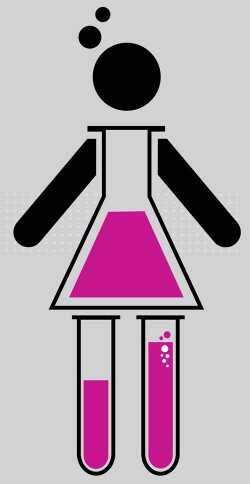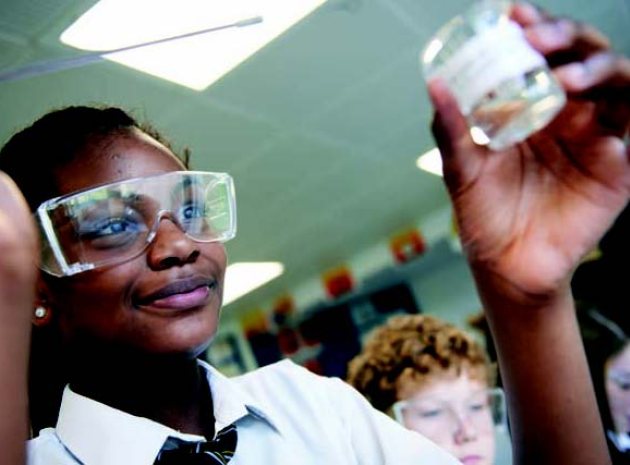The under-representation of girls studying physics post-16 in England has once again hit the national news headlines, with the proportion of female candidates for A level physics in England sticking stubbornly at just over 20% over the past 20 years. The catalyst for journalistic interest this time was the recent publication of the Institute of Physics’ (IoP) report, ‘It’s Different for Girls’, on the uptake of A level physics in 2011 in England, and is based on data from the National Pupil Database, linking the type of school at which girls studied GCSE with their progression (or not) onto A level physics courses. The conclusions offer some interesting food for thought for teachers of any science subject, with one finding being that the progression rate for girls onto A level physics depends much more on their school type than it does for boys. Also, unsurprisingly, the report finds that teachers and peers play a vital role in determining whether or not girls (and boys) decide to pursue physics at A level and beyond.
It is crucial that physics teachers – both specialist and nonspecialist – are given the necessary support, training and resources to develop their professional expertise in teaching physics and, in so doing, inspire and encourage both girls and boys to study physics.

Over the past eight years, the IoP and the National Network of Science Learning Centres (sciencelearningcentres.org.uk) have developed a number of teacher development programmes using successful teaching and learning strategies found to engage girls with physics and science subjects more generally. As PGCE lead science tutor at Southampton’s Education School, I have been involved in the research and development of these, which have been well received, with many teachers commenting on how their approach to teaching science subjects has changed after taking part.
The initial professional development programme involving the Science Learning Centres and the IoP, ‘Girls into Physics’, focused on engaging girls with physics, however, with the subsequent Action Research in Physics Programme (ARPP) it became clear that the changes in classroom practice actually worked to encourage all students into greater enjoyment of physics.
Using the findings and recommendations of the Girls into Physics and Action Research programmes, the Science Learning Centres’ physics courses have a strong evidence base running through them, so that participants can see the reasons why certain actions or strategies are taken. Action research is core to the courses, whereby participants select a research question they would like to investigate and consider the impact it has had on their teaching and pupils’ learning. The majority of teachers report back that undertaking action research has extended and deepened their practice as professionals.
The long game
At the nine regional Science Learning Centres, the ARPP has been developed into the ‘Effective Classroom Enquiry through Action Research’ course. This course takes the areas of good practice identified by the ARPP, and allows teachers and lecturers to carry out an action research project in their own classrooms. It takes place over the space of a year, and consists of three face-to-face training days during which participants are supported in developing and planning research questions, conducting their research and sharing the outcomes. In the time between training days, participants carry out their research, using eCPD to encourage collaborative working and mutual support.
At the National Science Learning Centre, the course ‘Success in Teaching 11-16 Physics for Specialists’ is also based on the findings from the Girls into Physics research. Over the space of two residential periods participants look in detail at how they can embed good practice in their classroom, looking, for example, at how to develop a ‘big picture’ of physics and identifying appropriate contexts and careers. In the time between the residentials, participants carry out action research in their own classrooms and share their findings when they return.
As part of the online component of this course, a recent participant commented, “I have been using the strategies that involve pupils voicing opinions; particularly the continuum of opinions and stimuli pictures, and opinions and quotes to start discussions and debates. I have found that many pupils who are conscientious (but who are maybe not as interested in science as humanities or English) have become much more engaged in my lessons. They have said that they feel more involved in Science and it has given them a different perspective.”
Outcomes and impact
Through the initial research programmes, six areas of good practice were identified that could improve attitudes to inspiring girls and boys to study physics, and these provide the basis for most of the action research projects carried out:
1. Learning and teaching strategies
2. Classroom management
3. Careers education and guidance
4. Progression
5. Workforce
6. Culture and ethos
On the ‘Success in Teaching 11-16 Physics for Specialists ’ course at the National Science Learning Centre, many of the action research projects link to the first four areas of good practice on this list. As both the ‘Girls into Physics’ and ARRP programmes progressed, in both instances teachers developed case studies around their experiences. A significant response from many teachers involved related to the positive impact of the community of practice that developed, principally within the course cohort, but also, for some teachers, within their school departments, the wider school community, and sometimes other local schools. Teachers from both projects said that their participation has led to a sustainable change in their practice.
For many of the teachers, this was their first experience of an action research approach to developing their own teaching practice, and there were surprises for them and their colleagues in the output from their research. Introducing practice in which the student voice was asked for and listened to was a powerful experience for some:
“Our main issue is not just with take up with physics but also with science and a negative attitude to science in general. The pre-questionnaire we did on students’ attitudes was a big wake up call to the department. We were shocked just how much students hated science, and this generated a lot of discussion about how we would tackle this.” (Girls into Physics participant)
A participant on the ARPP commented on increased confidence in integrating careers education into physics lessons: “We now have a better appreciation of how and why to integrate careers education into physics lessons. Also, the findings from this action research have prompted us to change our approach to teaching physics. We are careful to point out to students which parts of the science curriculum are physics, and try to introduce and discuss physics-related careers as we go along. Closer attention is also paid to avoiding gender-oriented language and stereotyping by relating certain careers to men or women.”
Drawing conclusions
The latest publication from the IoP looks at the issue of girls’ participation from a slightly different angle. A consistent message is that effective practice change is difficult to sustain unless it is part of a long-term programme that includes the whole school and beyond. The final two areas of good practice identified above – workforce and culture and ethos – are the ‘whole school’ areas that still need to be tackled if schools are to truly embed the importance of science teaching and learning for girls and boys into the culture of the entire school.
Looking at the evidence from A level participation in 2011, the IoP has made a series of recommendations to government, headteachers and parents, in the hope that a change of attitude on a much wider scale than just in the classroom might allow physics to be “represented in schools to boys and girls alike as an exciting, relevant and deeply enriching subject that will open up new opportunities throughout their careers.” (IoP 2012)
Info bar
• The teachers’ case studies, with resources, can be read here: tinyurl.com/d9zfbcv
• Briefing sheets are also available for senior school leaders and for parents with recommendations and other resources via tinyurl.com/cftuo7o
• To find out more about courses on offer at the national network of science learning centres, go to sciencelearningcentres.org.uk
• To find out more specifically about physics cpd courses on offer at the national science learning centre and across the network of science learning centres, visit www.slcs.ac.uk/go/nat/physicscourses and www.slcs.ac.uk/go/net/physicscourses
About the author
Caro Garrett, is pgce science lead tutor at Southampton Education School, University of Southampton. she co-authored the 2011 action research for physics programme final report which you can read here: tinyurl.com/dyo3rw9











“Changes in classroom practice actually worked to encourage all students into greater enjoyment of physics...”